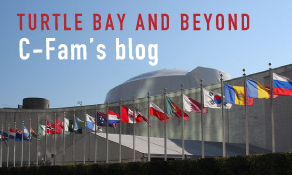WASHINGTON, D.C., November 16 (C-Fam) Family-planning potentates donned super-hero masks at a conference in Rwanda this week, touting their “family-planning super powers.”
Even so, it was abortion that took center stage as $350 million in new family planning funding was announced by Canada, the United Kingdom, and the Gates Foundation, a new initiative that prominently features abortion alongside contraception.
All this happened at what organizers touted as the world’s largest biannual family planning conference in Kigali, Rwanda.
At the opening ceremony, Canadian development minister Marie-Claude Bibeau announced a new “OPTions Initiative” focused entirely on abortion, and “in direct alignment with Canada’s Feminist International Assistance Policy.” Similarly, the UK’s Women’s Integrated Sexual Health (WISH) project funds abortion and is operated by abortion-promoting groups.
Despite the fact that international consensus holds that family planning does not include abortion, the dominant discourse within the international family planning movement is strongly pro-abortion. Abortion-providing groups, including the International Planned Parenthood Federation, Marie Stopes International, and Ipas, co-sponsored the event and conducted panels on expanding access to abortion.
The presence of the U.S. international assistance agency (USAID) among the sponsors, along with the Christian aid organization World Vision, did little to blunt the overwhelmingly pro-abortion tenor of the conference. In fact, one cosponsor was the She Decides campaign, which several European countries initiated to undermine the Trump administration’s policy of blocking U.S. aid money from going to abortion proponents overseas. A Thursday morning side event sponsored by several pro-abortion groups focused on the purported harms of this policy.
Organizers were disappointed with progress toward the conference’s central goal that continues to be dismal. At the same conference in 2012, the FP2020 initiative was launched with the ambitious target of adding 120 million new contraceptive users by 2020. Yet the latest progress report claims only 46 million new users in that time, leading FP2020 spokespeople to admit that they will never make up the difference in the next two years: “the hill is simply too steep to climb.”
Why is the FP2020 goal so off-target? The answer may lie in the tendency of family planning advocates, including scientific experts, to equate access to family planning with use, and to assume that non-use means a lack of access. When only 5% of women in developing regions described as having a “need” for family planning claim a lack of access, the true barrier to the FP2020 goal of adding new users may lie in a market already saturated. Additionally, high rates of discontinuation among contraceptive users has led to technical debates over what constitutes a “new user” in the first place.
Meanwhile, the conference was silent on new technologies that allow women to track and thereby avoid their fertile times. For instance, there are new phone-based applications for tracking fertility. Only one group spoke about such developments, a Georgetown University-based research group supported by USAID.
Given the high rate of contraceptive discontinuation by dissatisfied users, and the fact that religious objections are a significant reason why women reject contraception, fertility tracking approaches have the potential to fill an important gap in helping women and families achieve their objectives. However, this would require a shift in the entrenched discourse of the family planning movement, which remains more determined to fit abortion under the family planning umbrella than include innovative methods of managing fertility in a non-contraceptive way.
View online at: https://c-fam.org/friday_fax/abortion-dominates-family-planning-conference/
© 2025 C-Fam (Center for Family & Human Rights).
Permission granted for unlimited use. Credit required.
www.c-fam.org









